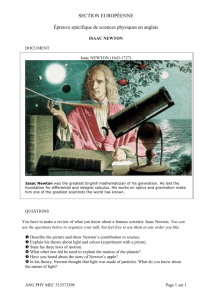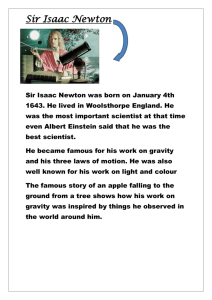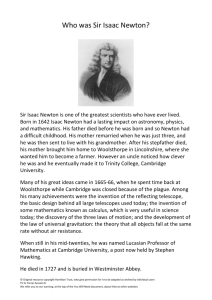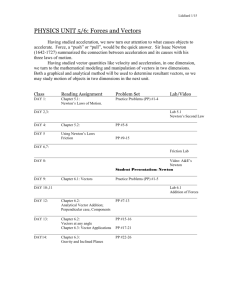forces & newton's laws - Department of Physics and Astronomy
advertisement
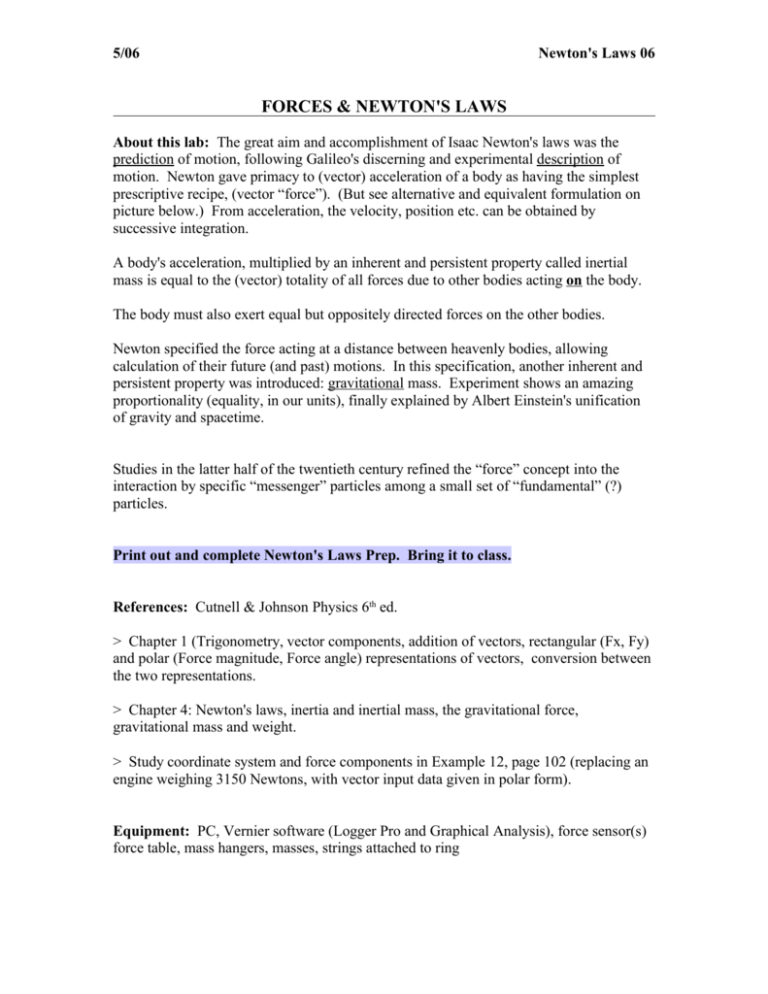
5/06
Newton's Laws 06
FORCES & NEWTON'S LAWS
About this lab: The great aim and accomplishment of Isaac Newton's laws was the
prediction of motion, following Galileo's discerning and experimental description of
motion. Newton gave primacy to (vector) acceleration of a body as having the simplest
prescriptive recipe, (vector “force”). (But see alternative and equivalent formulation on
picture below.) From acceleration, the velocity, position etc. can be obtained by
successive integration.
A body's acceleration, multiplied by an inherent and persistent property called inertial
mass is equal to the (vector) totality of all forces due to other bodies acting on the body.
The body must also exert equal but oppositely directed forces on the other bodies.
Newton specified the force acting at a distance between heavenly bodies, allowing
calculation of their future (and past) motions. In this specification, another inherent and
persistent property was introduced: gravitational mass. Experiment shows an amazing
proportionality (equality, in our units), finally explained by Albert Einstein's unification
of gravity and spacetime.
Studies in the latter half of the twentieth century refined the “force” concept into the
interaction by specific “messenger” particles among a small set of “fundamental” (?)
particles.
Print out and complete Newton's Laws Prep. Bring it to class.
References: Cutnell & Johnson Physics 6th ed.
> Chapter 1 (Trigonometry, vector components, addition of vectors, rectangular (Fx, Fy)
and polar (Force magnitude, Force angle) representations of vectors, conversion between
the two representations.
> Chapter 4: Newton's laws, inertia and inertial mass, the gravitational force,
gravitational mass and weight.
> Study coordinate system and force components in Example 12, page 102 (replacing an
engine weighing 3150 Newtons, with vector input data given in polar form).
Equipment: PC, Vernier software (Logger Pro and Graphical Analysis), force sensor(s)
force table, mass hangers, masses, strings attached to ring
5/06
Newton's Laws 06
Part A:
Equilibrium in Motion in One Dimension
Newton's Second law: Aerodynamic Drag Forces
F = ma ? This is useful, if we can specify F independently; otherwise not.
So, think: Recipe = mass x acceleration.
If we measure acceleration vs. time experimentally, we can say we know the “force”. But
this is only useful for prediction if we can infer a general recipe from the observed
acceleration (or a set of accelerations under varying circumstances). You will follow this
procedure to infer some properties of the aerodynamic force acting on a weighted coffee
filter in modified fall under the earth's gravitational influence.
Shuttle re-entry depends crucially on aerodynamic drag to dissipate excess energy and
reduce velocity for landing. This is achieved by pitching the nose up initially about forty
degrees and presenting refractory ceramic tiles to the hot plasma sheath which forms.1 It
is important to do it right – too shallow and the shuttle may skip into space forever, too
steep and it may burn up.
The driver of an auto traveling at the speed limit adjusts the accelerator pedal for
constant equilibrium) speed, at which the force on the tires equals (in magnitude) the
drag force.
The whole curve of drag force vs. speed is complex, and fit empirically. In higher
velocity regimes, such as for the two previous examples, the drag force is proportional to
the square of the velocity (turbulent flow). At low speeds, it becomes linear in speed
(viscous drag).
From the NASA site http://www.grc.nasa.gov/WWW/K-12/airplane/termv.html ,
1 Some say that this method could never work for higher velocity returns, and that return to a non-flying
spherical space capsule will be needed, e.g.for Mars flight
5/06
Newton's Laws 06
Note: NASA's r above is the air density ρ (Greek rho) below.
which says that, at terminal velocity, (no acceleration <-> equilibrium <->
zero net force) the aerodynamic drag force is equal (in magnitude) and
opposite (in direction) to the gravitation force W (weight m*g). It also says
that the drag force (equal to weight at equilibrium) is proportional to v 2
(true for turbulent flow at sufficiently high velocities), to area A and to air
density ρ , with constant of proportionality 2 {C drag/2} . At v < v term, the
drag force < W = mg. so the falling object continues to accelerate.
A non-fundamental force recipe: Aerodynamic drag
Aerodynamic drag involves the statistical effects of many collisions between the moving
object and air molecules. Ionization may be involved (as in shuttle re-entry). The
fundamental force involved is electromagnetic (see A Modern View of Force below).
But a useful force “law” ( = recipe) for the turbulent velocity regime can be predicted
theoretically and tested empirically.
2 The 2 produces a volume energy density form, if the drag equation is rewritten as ½ ρv2 = mg/CAfilter .
5/06
Newton's Laws 06
Open Logger Pro 3, Experiments, Sample Movies, Air Resistance, Air Resistance
06.cmbl. Select run 1, start; then run 2. Take the mass of a single coffee filter to be
0.001 kg, and it's diameter to be 0.017 meters.
Analyze: Select and Analyze (Linear Fit) the later (~ straight) portion of the two y vs. t
curves. The individual slopes give the two terminal velocities for the two different
masses. Square these terminal velocities and take the difference. Divide this difference
by the difference in masses. Call this “mass slope”. (This saves time; the result should
be the same as the slope of a linear fit to the (two point graph) of terminal velocity
squared vs mass.)
From the coffee filter slope data, predict your own sea level free-fall terminal velocity at
8000 feet. This depends on the air coefficient of drag Cd and on g. Assume these to be
the same at sea level and at 8000 feet; they are built in to the coffee filter slope data, so
we don't need to include them. The atmospheric density changes between 1.225 (mean
sea level) to ~ 0.960 at 8000 feet (kg/m 3); also your mass and projected area during free
fall differ from the coffee filter; you must correct for these differences. We know how to
correct from the above terminal velocity formula:
vyou2 = [coffee filter mass slope] x [your mass] x [(area,cf)/(area,you)] x [(density,sea
level)/(density/8000 feet)].
DON'T FORGET TO TAKE THE SQUARE ROOT TO GET v,you.
Use consistent mks units. Assume (area,you) is 2 meter 2 . Input your mass M in kg (1 kg
= 2.2 pounds). Convert v,you from meters/second to miles/hour. Show your calculations
and list your mass in kg and your terminal velocity in mph on your report. (1 m/s = 2.237
mph).
Reports on terminal velocities on the hypertextbook and goingtovegas web sites give
values from 50 to 100+ mph.
http://www.auf.asn.au/groundschool/umodule2.html#density gives air densities to 53000
feet.
http://hypertextbook.com/facts/JianHuang.shtml gives a terminal velocity around 55 m/s
(with one outlier), but no information about the altitude, e.g about air density.
http://www.goingtovegas.com/kpv-dive.htm states that the terminal velocity is around
120 mph (~ 54 meters/second) between 12000 and 4000 feet (novice + jumpmaster,
tandem jump).
5/06
Newton's Laws 06
Part B: Equilibrium at Rest in Two Dimensions: A Vector Exercise
A force table is shown below. Several cords are attached to a small ring at the center.
Each cord goes over a pulley to a hanger from which "weights" (masses) can be
suspended. The force with which each cord pulls is equal to the weight hanging from it.
The Force Table
The weight of each hanging object (in Newton's) is equal to its gravitational mass (in
kilograms) times the earth-surface constant g (9.80 m/s2), or to mass in grams times
0.00980. A corresponding string tension force is produced, which acts in the horizontal
(two-domensional) plane on the ring. Keep in mind that the hangers, too, have mass (50
g) that must be included in the calculation. (Neglect cord masses).
Analytical and graphical equilibrium condition determination with Graphical
Analysis
A Graphical Analysis template Newton's Second law: Unknown Equilibrium
Force.ga3 has been constructed to do the trigonometry associated with the given forces
(calculation of rectangular force components), and to do the component additions. You
need to understand the equilibrium conditions (as many as there are spatial
dimensions in the problem), know that force is a vector, and be able to transform a
vector back and forth between rectangular (x,y) and polar (r,θ) coordinates.
You must:
5/06
Newton's Laws 06
> Enter in the Page 1 table the masses in kg, along with their directions counter
clockwise from + x-axis (angles in degrees). You can choose your own x- axis (the theta
= 0 direction). Usually you will choose the x-axis along one of the force directions.
For force 1, substitute for m1 and theta1 in the table, etc. If you have no given third
mass, enter zeros for m3 and theta 3 . Leave the 0's alone; they make the polygon work.
> After you enter the given masses and direction angles, the program multiplies the given
masses by g = 9.8 to calculate the corresponding force components in Newtons, applies
cosine and sine factors to generate x and y components, and sums (separately) these x and
y components.
> Now your work begins. Look at the x and y sums. They should be non-zero (unless
the given forces happen to produce equilibrium, in which case your work is done.) If not,
then you must convert this non-equilibrium net force to a magnitude (F 4) and direction
(theta 4'), convert the magnitude to the mass m4 which would produce it (divide by g),
reverse the direction (to counter balance the other forces), enter your m4 and theta 4, and
check that the sums are now zero and that the polygon on Page 2 now closes.
Analytical Procedure:
Magnitude of F 4: sqrt(sum of squares of component sums) (Pythagorean theorem);
Mass m4: = F 4/g = F 4/9.8 . Enter this.
Direction theta 4 of vector sum of given forces: arctan(Σ F y)/Σ F x).
Check which quadrant. Then reverse this (add or subtract 180 degrees) to find
Direction theta 4 of unknown force which will produce equilibrium. Enter this.
Check your analytical solution: Final force component sums (xz and y separately)
should be 0, and force polygon on Page 2 should close.
Try your solution on force table. Don't expect perfection – there is friction in pulleys.
Study the graphics below.
5/06
Newton's Laws 06
Newton's Second Law.Equilibrium Demo.ga3, Page 1. The first two data columns
are manual input, the rest are calculated. The alternating rows of zeroes force the
GA “connect the points” graph option to return to zero in generating the force
polygon graph.
Note that the ultimate sums sumFx and sumFy are now zero and a fourth vector has
appeared in each graph.
Initial data produces a vector sum graph (sumFy vs. sumFx) which does not close. If
there were no additional force, there would be disequilibrium, and the net
(penultimate) sumFx would produce x acceleration, the penultimate sumFy would
produce y acceleration (accelerations depending on accelerated mass.)
But, this is an equilibrium problem. The needed additional mass must produce a
string tension force to cancel the penultimate sumFx and sumFy of all the others
(opposite component signs, opposite direction.)
5/06
Newton's Laws 06
Newton's Second Law.Equilibrium Demo.ga3, Page 2. Equilibrium Force Vector
Addition graph, showing (approximately) true angles (vertical and horizontal scales
approximately equal). Closure is the graphical condition for equilibrium; this does
not depend on whether vertical and horizontal scales are equal.
In each of the following diagrams a set of masses (grams) is shown. The object is to find
that force, referred to as the "missing force", to be added to the given set of forces to
produce equilibrium (centering of ring).
Quantities shown are masses in grams. Enter in kg! Common factors (e.g., g, mass unit)
only change the numbers, but not vector proportions; however, the .ga3 programs enter g
= 9.8 to calculate forces in Newtons.
1. First Open and study carefully the completed Newton's Second Law.Equilibrium
Demo.ga3 for procedure. Re-read the steps listed above.
Then, pick a case or two and use the Graphical Analysis template Newton's Second
Law.Unknown Equilibrium Force.ga3 to add the given forces by the method of
components, and also graphically.
5/06
Newton's Laws 06
Use the penultimate sumFx and sumFy values to predict by calculation the component
((x,y) rectangular coordinates) representation and then the magnitude and direction (|F|
,θ) representation of the missing force needed to give equilibrium. Calculate and enter the
corresponding mass with the angle as m4 and th4 in the first two (manual) data columns
on page 1. You don't need to adjust the vertical and horizontal scales for every graph to
produce approximately true angles – just check for polygon closure.
Experimental check of theory. Make a sketch showing the approximate direction you
expect for your missing mass, in order to produce equilibrium. Then set up the known
forces and your calculated values for missing mass and angle ( m 4 and th 4 ). If the
agreement is reasonable, note on report. If not, recheck all your inputs to your
calculations (numerical values and units) , since the correctness of the calculations for the
numbers you typed in are already checked graphically (polygon closure) and analytically
(x and y force sums ~ 0).
Print and submit Page 2 (graphical solution) for one case only (specify the case;
print names and note how well experimental check agrees with your predictions).
5/06
Newton's Laws 06
5/06
Newton's Laws 06
An Experimental Example of Newton's Third Law
There is probably not time to reproduce the experimental result shown in the graph
below, which involves two identical strain gauges (force sensors) hooked together and
tugged apart repeatedly.
Pulls – the sensors are not well zeroed. Equal (magnitude) and opposite (direction)
forces between two interacting bodies – Newton's Third Law
5/06
Newton's Laws 06
A Modern View of “Force”
Born: 4 Jan 1643 in Woolsthorpe, Lincolnshire, England
Died: 31 March 1727 in London, England
Note the banknote form of Newton's second law, which can be written F = d/dt(mv) =
time rate of exchange of linear momentum, m*v. If m is constant, this is equivalent to F
= ma. But, in special relativity, the inertial mass m varies in a known way as an object's
speed changes relative to the observer. So, although Newton certainly did not anticipate
Einstein's special relativity, his formulation survives its advent. But we will study objects
moving at small velocities (relative to light speed), so F = ma is an excellent
approximation for us.
For more commentary, see http://en.wikipedia.org/wiki/Newton's_laws_of_motion .
Isaac Newton was born in the manor house of Woolsthorpe, near Grantham in
Lincolnshire. Although by the calendar in use at the time of his birth he was born on
Christmas Day 1642, we give the date of 4 January 1643 in this biography which is the
"corrected" Gregorian calendar date bringing it into line with our present calendar. (The
Gregorian calendar was not adopted in England until 1752.) Isaac Newton came from a
family of farmers but never knew his father, also named Isaac Newton, who died in
October 1642, three months before his son was born. Although Isaac's father owned
property and animals which made him quite a wealthy man, he was completely
uneducated and could not sign his own name.
5/06
Newton's Laws 06
Isaac's mother Hannah Ayscough remarried Barnabas Smith the minister of the church at
North Witham, a nearby village, when Isaac was two years old. The young child was then
left in the care of his grandmother Margery Ayscough at Woolsthorpe. Basically treated
as an orphan, Isaac did not have a happy childhood. His grandfather James Ayscough was
never mentioned by Isaac in later life and the fact that James left nothing to Isaac in his
will, made when the boy was ten years old, suggests that there was no love lost between
the two. There is no doubt that Isaac felt very bitter towards his mother and his step-father
Barnabas Smith. When examining his sins at age nineteen, Isaac listed:Threatening my father and mother Smith to burn them and the house over
them.
Upon the death of his stepfather in 1653, Newton lived in an extended family consisting
of his mother, his grandmother, one half-brother, and two half-sisters. From shortly after
this time Isaac began attending the Free Grammar School in Grantham. Although this was
only five miles from his home, Isaac lodged with the Clark family at Grantham. However
he seems to have shown little promise in academic work. His school reports described
him as 'idle' and 'inattentive'. His mother, by now a lady of reasonable wealth and
property, thought that her eldest son was the right person to manage her affairs and her
estate. Isaac was taken away from school but soon showed that he had no talent, or
interest, in managing an estate.
An uncle, William Ayscough, decided that Isaac should prepare for entering university
and, having persuaded his mother that this was the right thing to do, Isaac was allowed to
return to the Free Grammar School in Grantham in 1660 to complete his school
education. This time he lodged with Stokes, who was the headmaster of the school, and it
would appear that, despite suggestions that he had previously shown no academic
promise, Isaac must have convinced some of those around him that he had academic
promise. Some evidence points to Stokes also persuading Isaac's mother to let him enter
university, so it is likely that Isaac had shown more promise in his first spell at the school
than the school reports suggest. Another piece of evidence comes from Isaac's list of sins
referred to above. He lists one of his sins as:... setting my heart on money, learning, and pleasure more than Thee ...
which tells us that Isaac must have had a passion for learning.
Isaac Newton's life can be divided into three quite distinct periods. The first is his
boyhood days from 1643 up to his appointment to a chair in 1669. The second period
from 1669 to 1687 was the highly productive period in which he was Lucasian professor
at Cambridge. The third period (nearly as long as the other two combined) saw Newton as
5/06
Newton's Laws 06
a highly paid government official in London with little further interest in mathematical
research.
Newton's accomplishments were of astonishingly broad scope. For example, as a sidelight
to his fundamental contributions in physics and astronomy, he (in parallel with Liebnitz)
invented the mathematical discipline of calculus. The poet Alexander Pope was moved
to pen the lines
Nature and Nature's laws
lay hid in night;
God said, Let Newton be!
and all was light
http://www-gap.dcs.st-and.ac.uk/~history/Mathematicians/Newton.html
Prior to the 20th century, the nature of classical gravitation and electrostatics (both 1/r2
laws, point to point) were known from the work of Galileo, Kepler, Newton, and
Coulomb. The essential character of classical electro-magnetism (they are a unity, along
with the less familiar but also fundamental weak interaction) was known from the work
of Faraday, Maxwell, Hertz, Lodge and others. Natural radioactivity had just been
discovered through the enormous labor of Marie Curie.
Einstein discovered theoretically a profound connection between gravitational mass and
space-time with space-time being, not passive, but warped and shaped by its gravitating
contents. Predictions of this view have been experimentally verified.
In the 20th century physicists studied these and found two additional force types of short
range, called the weak and strong. Of all these, gravity is by far the weakest.
With the discovery and elucidation of the essential quantum mechanical nature of
our universe, physicists associated particle quanta (discrete bundles) with these
force messenger carriers of the corresponding interactions among matter particles.
The best known is the photon, the electromagnetic force carrier of the electromagnetic
interaction between charged particles. The graviton, gravity's force carrier has not been
observed, due to the extreme weakness of the interaction. The weak force carriers (W+ -,
Z0) have been observed, with the help of particle accelerators; the strong force carriers are
gluons, believed to be permanently bound, along with quark building blocks, in
composites such as neutrons and protons.
Discussion of the force messenger particles requires also discussion of the matter
particles the messengers serve.
A Standard Model of point matter and force messengers (without gravity, which plays
little role in atoms, nuclei etc., but which is attractive only and therefore dominant in the
5/06
Newton's Laws 06
large (because there is no cancellation, as there is with Coulomb forces) has been
painstakingly constructed, with three matter families. Why three families, and the
possible relations among them, are unknown, leading to an attempt called “string theory”
(small but extended objects), to unify further the picture below. This is a highly
mathematical subject, with the exact theoretical form not yet known. However, it has
been shown that quantum gravity and a graviton force carrier of correct properties must
be present in these theories, whereas it the graviton presents great difficulty in the pointparticle Standard Model. This has encouraged string theorists.
Note that quarks have fractional charge (in electron charge units). The neutrons and
protons of our atoms are made up of three quarks, mesons of two. In the standard model
quarks are fundamental, along with electrons and neutrinos (leptons, = light elementary
particles) and their analogues of the second and third families. The quark concept,
supported by experiment, produces an enormous simplification in the description of the
very many observed composite particles.
Particle classes (quarks and leptons in three families) and the force
messenger particles between them, according to the point particle
Standard Model.
There is a corresponding chart of “anti-particles” identical to the
“particles” in mass, but opposite in other properties such as electric
5/06
Newton's Laws 06
charge sign. The host of observed particles (protons, neutrons, pi
mesons, etc.) which are not shown above are quark composites.
